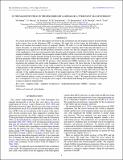IS THE MAGNETIC FIELD IN THE HELIOSHEATH LAMINAR OR A TURBULENT SEA OF BUBBLES?
Author(s)
Opher, M.; Drake, J. F.; Swisdak, M.; Schoeffler, K. M.; Richardson, John D; Decker, R. B.; Toth, G.; Richardson, John D.; ... Show more Show less
DownloadOpher-2011-IS THE MAGNETIC FIEL.pdf (3.982Mb)
PUBLISHER_POLICY
Publisher Policy
Article is made available in accordance with the publisher's policy and may be subject to US copyright law. Please refer to the publisher's site for terms of use.
Terms of use
Metadata
Show full item recordAbstract
All current global models of the heliosphere are based on the assumption that the magnetic field in the heliosheath, in the region close to the heliopause (HP), is laminar. We argue that in that region the heliospheric magnetic field is not laminar but instead consists of magnetic bubbles. We refer to it as the bubble-dominated heliosheath region. Recently, we proposed that the annihilation of the "sectored" magnetic field within the heliosheath as it is compressed on its approach to the HP produces anomalous cosmic rays and also energetic electrons. As a product of the annihilation of the sectored magnetic field, densely packed magnetic islands (which further interact to form magnetic bubbles) are produced. These magnetic islands/bubbles will be convected with ambient flows as the sector region is carried to higher latitudes filling the heliosheath. We further argue that the magnetic islands/bubbles will develop upstream within the heliosheath. As a result, the magnetic field in the heliosheath sector region will be disordered well upstream of the HP. We present a three-dimensional MHD simulation with very high numerical resolution that captures the north-south boundaries of the sector region. We show that due to the high pressure of the interstellar magnetic field a north-south asymmetry develops such that the disordered sectored region fills a large portion of the northern part of the heliosphere with a smaller extension in the southern hemisphere. We suggest that this scenario is supported by the following changes that occurred around 2008 and from 2009.16 onward: (1) the sudden decrease in the intensity of low energy electrons (0.02-1.5 MeV) detected by Voyager 2, (2) a sharp reduction in the intensity of fluctuations of the radial flow, and (3) the dramatic differences in intensity trends between galactic cosmic ray electrons (3.8-59 MeV) at Voyager 1 and 2. We argue that these observations are a consequence of Voyager 2 leaving the sector region of disordered field during these periods and crossing into a region of unipolar laminar field.
Date issued
2011-06Department
MIT Kavli Institute for Astrophysics and Space ResearchJournal
Astrophysical Journal
Publisher
Institute of Physics/American Astronomical Society
Citation
Opher, M., J. F. Drake, M. Swisdak, K. M. Schoeffler, J. D. Richardson, R. B. Decker, and G. Toth. “IS THE MAGNETIC FIELD IN THE HELIOSHEATH LAMINAR OR A TURBULENT SEA OF BUBBLES?” The Astrophysical Journal 734, no. 1 (May 25, 2011): 71. © 2010 American Astronomical Society.
Version: Final published version
ISSN
0004-637X
1538-4357